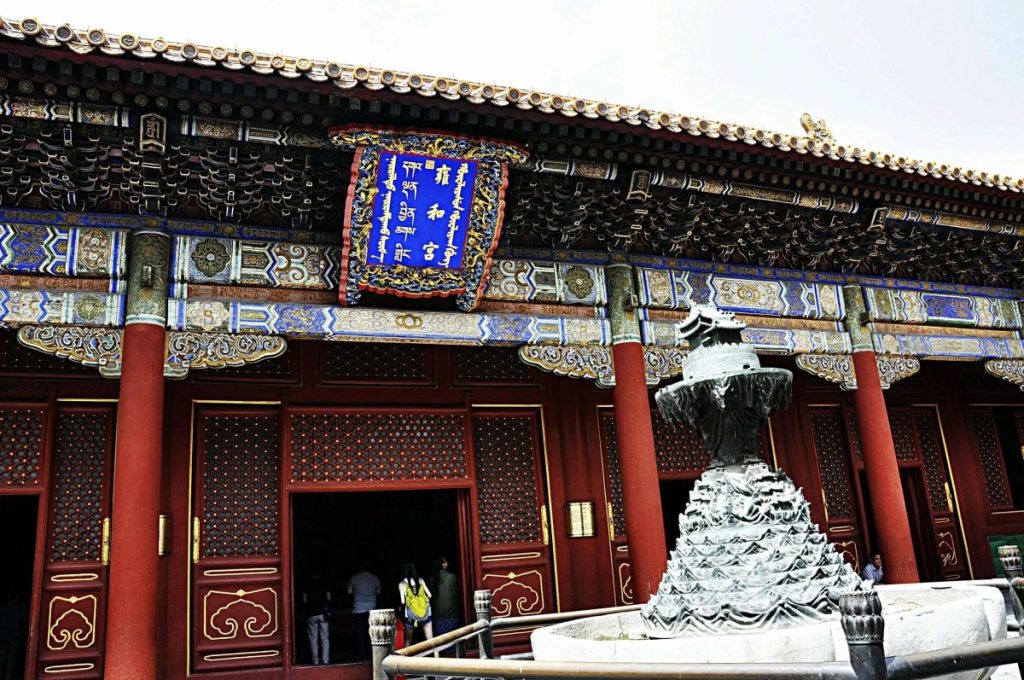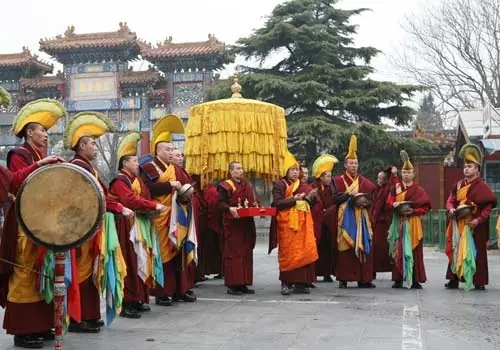Lama Temple (Yonghegong), located in Dongcheng District, Beijing, China, is a famous Tibetan Buddhist temple, attracting a large number of believers and tourists to worship and visit every day.It is not only a place of great popularity, but also carries a deep historical and cultural heritage.

Introduction of Lama Temple (Yonghegong)
The former Yonghegong Palace was actually the residence of Yinzhen, the fourth son of Emperor Kangxi of the Qing Dynasty, later known as Emperor Yongzheng.
This residence witnessed the birth and growth of Hongli (later Emperor Qianlong), and it can be said that it was full of royal flavor from the very beginning.
In the third year of Yongzheng, 1725, after Yinzhen ascended to the throne as emperor, he chose to convert the mansion into a palace, and named it “Yonghe Palace”.
In the ninth year of the Qianlong reign, 1744, the Yonghegong Palace was officially converted into a Tibetan Buddhist Gelugpa monastery, and since then, it has become an important holy place for the Buddhist community in Beijing and throughout the country.
The architectural style of the Yonghegong is unique, skillfully blending elements of both Han and Tibetan cultures.
The whole complex is covered with yellow glazed tiles and surrounded by red palace walls, making it both solemn and magnificent.
The temple halls, pavilions, scripture halls, monasteries and other buildings are staggered, the layout is rigorous, and every place reveals the exquisite skills and infinite wisdom of ancient craftsmen.

Detailed Tour Guide
Lama Temple (Yonghegong) consists of seven courtyards, each with its own unique charm and story.
The First Courtyard: Pai Lou Courtyard
When you step into the gate of the Lama Temple, the first thing that catches your eyes is a yellow glazed tile and golden nanmu made pagoda standing in the north and east-west directions. These pagodas are not only beautiful and generous, but also symbolize good fortune and holiness.
The Second Courtyard: Zhaotai Gate
Passing through the courtyard of pagodas, you will come to the entrance of the Yonghe Palace – Zhaotai Gate.
This is the starting point of the legendary tour of the Yonghe Palace, and also a must-visit place for every visitor.
Three Courtyards
Entering the third courtyard, you will be attracted by the ancient acacia.
On both sides of the ancient acacia, there are bell tower and drum tower, which beat the bell and drum day after day, as if telling the ancient story of Yonghegong.
And the main gate hall, Yonghemen Hall, enshrines Maitreya Buddha as well as the four heavenly kings, Weituo Bodhisattva and other Buddha statues, which is a place for believers to pray for happiness and smooth sailing.
Four courtyards
Continuing on, you come to the Yonghegong Palace.
This hall has nine ridges intersecting, giving it an imposing appearance.
Various Buddha statues are enshrined in the hall, which is a good place for believers to pray for good fortune.
The buildings such as the Imperial Tablet Pavilion and the Lama’s Speaking Pavilion are particularly magnificent with their glazed roofs and colorful painted and gold decorations.
Five courtyards
Among the five courtyards, the Yongyou Hall is a Tibetan-style building dedicated to Buddha statues such as the Buddha of Immeasurable Life, the Medicine Buddha, and the Lion’s Roar Buddha.
And the spirit stupa of the Fifth Lama is inlaid with gems and pearls, making it look opulent.
Here, believers can pray to get rid of evil spirits and eliminate disasters.
Yakushi Hall is a place for monks to learn Tibetan medicine, and the hall is dedicated to Yakushi Buddha and other Buddha statues, which is a good place to pray for health.
The Hall of the Wheel of Time is a place where monks study astronomy and calendars. Inside the hall are statues of the Wheel of Time Vajra and other Buddha statues, and believers can pray for good luck here.
Six courtyards
Dharma Wheel Hall is located in the Yongyou Hall after the Yonghe Palace, is the Yonghe Palace to hold major Buddhist activities.
Inside the hall are enshrined the statue of Shakyamuni Buddha and Buddhist classics, and it is a place for monks to study Buddhism and practice meditation.
The West Hall enshrines the statue of Sakyamuni and the eight Bodhisattvas, and is a good place to pray for academic progress.
The East Hall is dedicated to Tantric statues, where believers can pray for good fortune.
Seven Courtyards
The last courtyard is the Wanfu Pavilion, one of the landmarks of the Yonghe Palace.
This 25-meter-high building houses a huge white sandalwood Maitreya Buddha statue, which is 18 meters high and is the temple’s crown jewel.
Here, believers can pray for peace and good luck.
The buildings next to it, such as the Preceptor’s Building, the Banchen Building, and the Yarmandaga Building, each have their own unique charms and stories.
Characteristic Highlights
Lama Temple (Yonghegong) not only has a long history and deep cultural heritage, but also has many unique highlights worth seeing.
Copper incense burner: two dragons playing pearls, three lions playing ball shape, not only beautiful and generous, but also means good luck and harmony.
Five hundred Luohan carved from sandalwood: these Luohan have different and lifelike forms, which is a treasure of wood carving art.
Rain Dragon Changing Basin: made of golden sandalwood, the craftsmanship is exquisite and the shape is unique.
The white sandalwood solo carving of Maitreya Buddha statue in Wanfu Pavilion: this statue is not only huge in size, but also famous for its exquisite carving skills.
The golden sandalwood Buddha niche in the Shoufo Building: the niche is carved with 99 cloud-dragon motifs, making it look both magnificent and mysterious.
Practical Information
Ticket Price: The ticket price of Yonghegong is 25 yuan, which is extremely cost-effective.
Opening time: the Yonghegong is open from 9:00-17:00 (summer and fall), visitors can come to visit according to their own schedule.
Lama Temple (Yonghegong), a Buddhist shrine that combines elements of Chinese and Tibetan culture, not only carries a deep historical and cultural heritage, but also attracts tourists from all over the world with its unique charm. Whether you are a believer or a tourist, you can find your own share of tranquility and peace here.